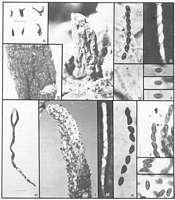|
 Xylaria furcata Xylaria furcata
BiostatusOccurrence uncertain
Images (click to enlarge)
Caption: Fig. 21 A-G Xylaria cf. myosurus A, Stromata. B, C, Stromal surface. D, Ascal ring (Melzer's
reagent). E, Ascospores in an ascus (Melzer's reagent). F, Three ascospores with germ slits
(Melzer's reagent). G, Immature ascospores with a |
Description: Stromata: Stromata upright (taller than broad), or filiform; stipitate; 70 mm tall; 2 mm diam.; perithecia inconspicuous, or conspicuous; ostioles finely papillate, or coarsely papillate; stromatal surface wrinkled, or more or less smooth; dark brown (brown vinaceous), or blackish; KOH-extractable pigments lacking; tissue below perithecia conspicuous, essentially homogeneous, white.
Perithecia: Perithecia more or less globose; 0.2 mm diam.
Asci: Amyloid ring broader than high, or higher than broad.
Ascospores: Ascospores 7.5-8.5 µm long; 3.5-4.5 µm wide; brown; 0-septate; in side view inequilateral, flattened on one side, not curved; in face view elliptic; ends narrowly rounded. Germ slit straight, spore-length; on flattened side of spore. Perispore indehiscent in 10% KOH.
Article: Rogers, J.D.; Samuels, G.J. (1987) [1986]. Ascomycetes of New Zealand 8. Xylaria. New Zealand Journal of Botany 24(4): 615-650 (http://www.rsnz.org/publish/abstracts.php).
Description: Stroma solitary, branched once dichotomously at apex, 7 cm long; fertile portion terminal,
cylindrical, circular in section, 1.5 em long x 2 mm diam.; light brown, glabrous, slightly
tubercuiate from protruding perithecial apices; perithecia c. 200 µm diam., with conical
apices. Internal tissue of stroma white, solid. Stipe sharply delimited from fertile protion,
2.5 mm diam., glabrous. Asci c. 65 µm total length x 5 µm cylindrical; apical ring J+, 2 µm
wide x 2 µm high; 8-spored, ascospores uniseriate with overlapping ends. Ascospores (7.0-)7.5-8.5(-9.0) x
3.5-4.0(-4.5) µm, inequilateral with one side flat and the other side round,
one-celled or with an inconspicuous cellular appendage (primary appendage) on one end,
transparent brown; slit full length, parallel to long axis of ascospore.
Habitat: HABITAT: On soil, possibly on buried wood.
Distribution: DISTRIBUTION: NORTH ISLAND: Northland, known only from one collection.
Notes: This fungus resembles X. furcata in the habit and colour of stromata. It differs
from typical X. furcata, however, in its substantially larger ascospores. Dennis (1961)
gives ascospores of African material as 4-5 x 2 µm and several specimens examined at
K have similar dimensions. Material depicted by Dennis (1961) is hairy overall, but
several specimens at K are glabrous. We have not seen type material of X. furcata.
We were unable to culture our material. According to Dixon (1965) the anamorph of X.
furcata is unique in producing two types of conidia which are violently discharged.
This conidial state has been named Padixonia bispora Subram. (Subramanian 1972).
Typical X. furcata is associated with termite nests. We were unable to determine
whether or not the New Zealand fungus was associated with insects.
|